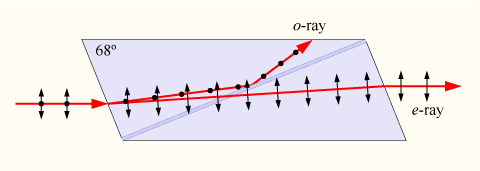.
Nicol prism

A Nicol prism
A Nicol prism is a type of polarizer, an optical device used to generate a beam of polarized light. It was the first type of polarizing prism to be invented, in 1828 by William Nicol (1770-1851) of Edinburgh. It consists of a rhombohedral crystal of calcite (Iceland spar) that has been cut at a 68° angle, split diagonally, and then joined again using Canada balsam.
Unpolarized light enters one end of the crystal and is split into two polarized rays by birefringence. One of these rays (the ordinary or o-ray) experiences a refractive index of no = 1.658 and at the balsam layer (refractive index n = 1.55) undergoes total internal reflection at the interface, and is reflected to the side of the prism. The other ray (the extraordinary or e-ray) experiences a lower refractive index (ne = 1.486), is not reflected at the interface, and leaves through the second half of the prism as plane polarized light.
Nicol prisms were once widely used in microscopy and polarimetry, and the term "crossed Nicols" (abbreviated as XN) is still used to refer to observation of a sample between orthogonally orientated polarizers. In most instruments, however, Nicol prisms have been supplanted by other types of polarizers such as Polaroid sheets and Glan-Thompson prisms.
See also
Retrieved from "http://en.wikipedia.org/"
All text is available under the terms of the GNU Free Documentation License

